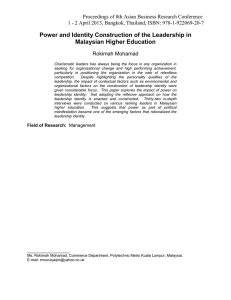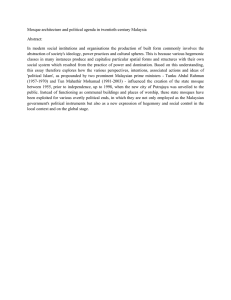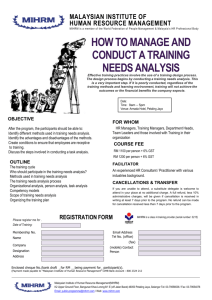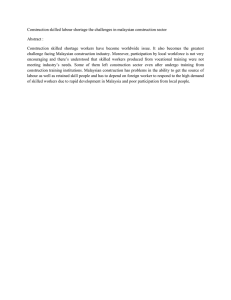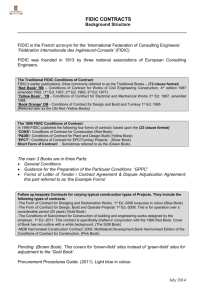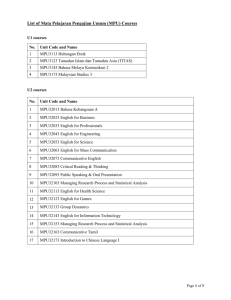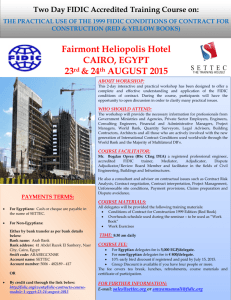CHAPTE R 1 INT RODU CT IO N 1.1 Background
advertisement
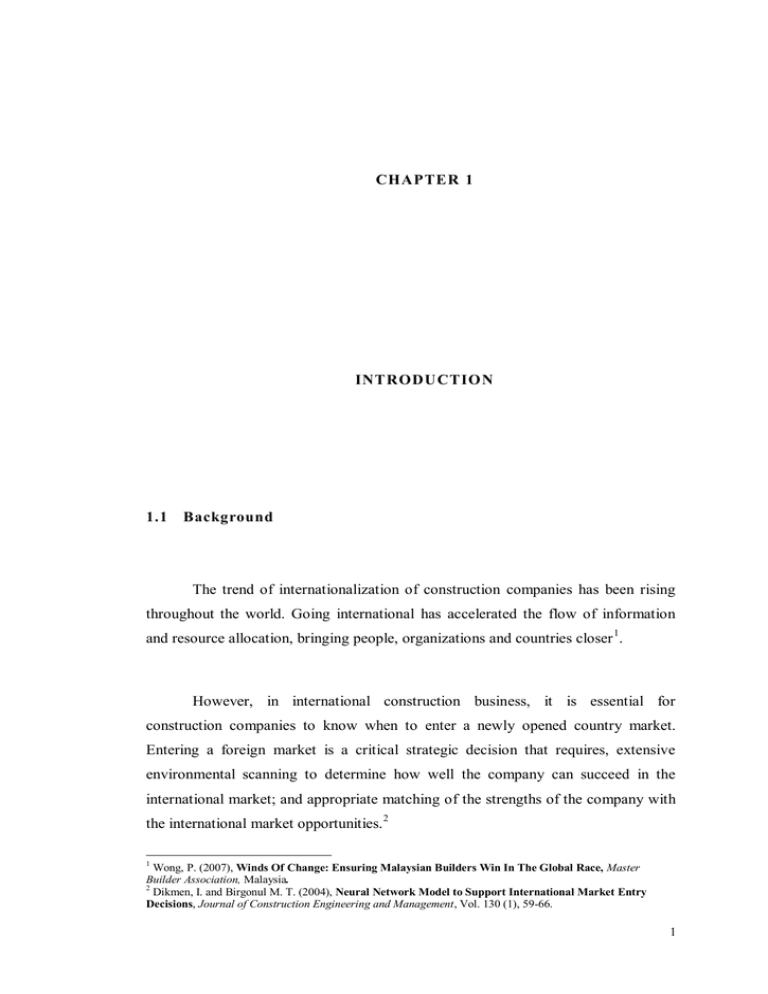
CHAPTER 1 1 1.1 INTRODUCTION Background The trend of internationalization of construction companies has been rising throughout the world. Going international has accelerated the flow of information and resource allocation, bringing people, organizations and countries closer 1. However, in international construction business, it is essential for construction companies to know when to enter a newly opened country market. Entering a foreign market is a critical strategic decision that requires, extensive environmental scanning to determine how well the company can succeed in the international market; and appropriate matching of the strengths of the company with the international market opportunities. 2 1 Wong, P. (2007), Winds Of Change: Ensuring Malaysian Builders Win In The Global Race, Master Builder Association, Malaysia. 2 Dikmen, I. and Birgonul M. T. (2004), Neural Network Model to Support International Market Entry Decisions, Journal of Construction Engineering and Management, Vol. 130 (1), 59-66. 1 Construction projects became more complex and multi-dimensional, demanding more disciplines and skills. Therefore, construction projects, nowadays, in developing countries are often carried out in joint ventures with construction companies from developed countries. International collaboration can be of particular benefit to all parties of projects. Trans-global economic developments offer an opportunity to develop products using the most up-to-date expertise and knowledge in a cost-effective manner.3 FIDIC Fédération Internationale Des Ingénieurs – Conseils (from French, the International Federation of Consulting Engineers) was initiated in 1913 as a global representative for the consulting engineering industry, to ensure successful international collaboration. Thus, FIDIC, today, is well known for the standard form Conditions of Contract for the worldwide construction industry, particularly in the context of higher value international construction projects, and is endorsed by many multilateral development banks (“MDBs”). Malaysian construction contractors have been progressively involved and continuously encouraged to undertake construction projects along side with multinational participants from diverse political, legal, economic, and cultural backgrounds. To search new geographical presence; To seize the opportunities brought by the global economy’s needs for higher standard of efficiency and quality; To increase global Market Share; To gain political power. Excellent performance of Malaysian contractors in the construction of many mega projects within the local industry has nurtured the competencies and capabilities of their expertise. However, the very competitive and saturated of local market has driven many Malaysian contractors to make significant appearance in the global market as a mean to effectively capitalize on special expertise. Malaysian construction companies has reported successful completion of international projects to Construction Industry Development Board’s CIDB 3 Clark, H., and Ip, A. (1999). ‘‘The Peifan-Lucky Star—A car for China.’’ Design Manage. J., Fall, 21–28. 2 (Malaysian government agency under the Ministry of Works which appointed as a professional body to promote, stimulate and assist the development of Malaysian construction industry). And that was comprehensively published in CIDB’s newsletter, issue 02 December 2012, as the latest update on international construction ventures. From 1987 to 31 Dec 2012, 115 Malaysian contractors have participated in a total of 691 construction projects worth about US$30 billion (RM102.2 billion) in 50 countries abroad. Out of these projects have completed 617 projects worth USD 19 billion (RM65.5 billion) worldwide, while another 74 projects worth USD 10.8 billion (RM36.7 billion) are still ongoing. The most number of international construction projects have been secured in the Middle East – 41 %, followed by South Asia at 21 %, ASEAN 14%, Africa 12% and other regions 21 %. There are 115 Malaysian contractors currently doing construction work in 50 countries around the globe. Recently, Middle East has proven to be one of the most attractive construction markets in the world as it continues to present significant opportunities for international contractors including Malaysian ones. 4 According to CIDB newsletter, issued 01 & 02 June 2013. The biggest projects received by Malaysian contractors in terms of value are from the Middle East. Malaysian contractors’ contribution is obvious in countries such as the UAE, Saudi Arabia, and other Middle Eastern countries where Malaysian companies participated in iconic construction projects such as the Burj Khalifa in Dubai and Capital Gate in Abu Dhabi. Construction groups like Muhibbah Engineering, Setia Group, Gamuda Bhd, Road Builder Holdings (M) Bhd, UEM Construction Sdn Bhd, IJM Corporation and Bina Puri Holdings Bhd had exported their expertise to the Middle East. However, in today’s complex world of construction, it is almost impossible to complete a project without issues arising during the process. In order to understand how and why these issues arise, they must be placed into proper perspective. 4 Raymont, M. (2010, March). THE EMERGENCE OF ASIAN CONSTRUCTION CONTRACTORS IN THE MIDDLE EAST. www.cmguide.org. Retrieved December 27, 2013, from http://www.cmguide.org/archives/2151. 3 What is the scenario of international construction process? What are the issues arising from working in different country? Under different legal system than the one practiced in home country, Malaysia? How did they (Malaysian contractors) overcome the language differences? How to implement FIDIC? Are the terms and conditions of FIDIC compatible with the legal system of that country? How was FIDIC interpreted by the parties of different backgrounds? How well is the FIDIC contract amended and drafted using words (apart from the drawings) to express in the light of events and circumstances in prospects? In general, what are the issues faced by other contractors working in the same host country? In case of disputes, how were they avoided/resolved? And many other questions triggered this research. 1.2 Problem Statement According to the CIDB Malaysian Construction Industry Master Plan, 2007, it is stated that some of the main challenges and difficulties facing Malaysian contractor in international project ventures are as follows: Opportunities – availability of projects. Chances of securing projects. Business environment–Legal system, language and others. Funding – whether the projects are government funded, multilateral agency funded or privately funded. Level of risk ranging from security risk to infrastructure risk. Ease of entry/exit – existence of trade and non-trade barriers and ease of repatriating profits. This research tends to focus on the third point of the list above and study in depth the common contractual issues that are creating obstacles for the Malaysian contractors performing in the Middle Eastern countries, Specifically, Saudi Arabia and United Arab Emirates (UAE), which occurs while using FIDIC forms of contract. Being located in Malaysia would make it a proper and beneficial site for my 4 study to analyze different legal system’s (Common Law in Malaysia, Civil law in UAE and Shari’ah Law in Saudi) interpretations, and examine the effect of different languages used for communication, in relation with the issues arising from the application of international construction contract (FIDIC). 1.3 Aim As the major issues affecting the management of international construction projects, legal contractual issues deserve wide research because it controls the financial and technical aspects of the construction project. This Master Project Thesis is not complete coverage of building contract (FIDIC) problems. The author’s consciousness of the gaps in the selected issues is based on the previous authors and practitioners emphasis on them. This study aims to identify and address the main contractual issues of different countries where Malaysian contractors undertaking projects. In order to, establish the guidelines to enhance more contract management efficiency of the FIDIC’s Conditions of Contract; to determine and mitigate the conflict causation by implementing an appropriate dispute avoidance mechanisms for international construction projects, especially for those carried out in the Middle East. 5 1.4 Objectives 1) To identify and categorise the issues arising from the use of FIDIC in the Middle East. 2) To determine the effect of the factors (legal systems, language and application of FIDIC) on the issues. 3) To determine the key issues arising from working in UAE and Saudi Arabia. 1.5 Scope This study focuses on the responses and data’s obtained from the Malaysian contractors performed construction projects in the Middle East using FIDIC conditions of the contract. There are many bespoke or standard forms of contracts in use internationally and it is not the purpose of this research to refer to them but rather use FIDIC as it is the most commonly used, therefore, avoid confusions that the reader may get by making quotations and illustrations from various forms of contracts. As discussed earlier, the main countries in the Middle East with numerous development projects are Saudi Arabia and United Arab Emirates. Therefore, limiting the study to these two countries is the scope of my research. 6 1.6 Research methodology The methodology adopted in this research is sub divided into several stages, viz.; identifying the research issues, literature review, data collection, data analysis, conclusion and recommendation. Refer to Error! Reference source not found. below. 1.6.1 Literature review Extensive literature review is carried out, using books, articles web sites and e-journals to produce and evaluate models. 1.6.2 Data collection Questionnaires sent to Malaysian contractor companies and personnels. Names and addresses of these companies are extracted from the Construction Industry Development Board (CIDB) web-based database list of contractors’ companies to enquire about their opinions, issues they overcame and strategies they followed to ensure success of their projects in the Middle Eastern countries by responding to the questionnaire. Face-to-face discussions about the issues mentioned in the questionnaire took place to determine other issues that are not mentioned in the questionnaire which would enhance the quality of the data and the research overall. 7 1.6.3 Data analysis The collected data will be studied, and analyzed using SPSS based on the issues. Data will be analyze and performed in tables and graphs for easy reference. 1.6.4 conclusion and recommendations Shows the findings and conclusion for this study. Recommendations are, also, suggested for contractors working or willing to work in Saudi Arabia or United Arab Emirates, to enhance the level of understanding of the construction/contractual issues faced by Malaysian contractor using FIDIC in the Middle East generally and Saudi Arabia or United Arab Emirates specifically. 8 Development of research proposal Common Contractual Issues faced by Malaysian contractors operating in Middle East using FIDIC form of contracts Literature Review Extensive literature review is carried out, using books, articles web sites and e-journals to: 1) Identify the problem 2) determine aims and objectives Objectives 1) To identify and categorise the issues arising from the use of FIDIC according to the frequency of occurrence. 2) To analyze the causes of issues in relation to legal systems, language and application of FIDIC. 3) To determine key legal issues arising from working in UAE and Saudi Arabia. Data Collection Collection of data Research Design Data Analysis The collected data will be studied, and analysed using SPSS based on the issues. Data will be analyse and performed in tables and graphs for easy reference. Conclusion and Recommendations Achieve the objectives Limitations Recommendations FIGURE 1: RESEARCH METHODOLOGY 9
